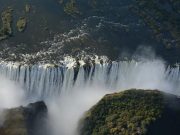In the vast tapestry of our world, where nature paints landscapes of vibrant diversity, the specter of drought casts an increasingly pervasive shadow. As climate patterns shift and water becomes a more precious commodity, the question arises: should tourists steer clear of regions grappling with drought? This inquiry delves into the complex interplay between the allure of travel and the ethical, environmental, and economic considerations that accompany it. In this exploration, we journey beyond the sun-soaked beaches and verdant mountains to consider the impact of our footprints on places where water scarcity challenges daily life. Through a balanced lens, we aim to uncover the responsibilities and repercussions tied to traveling in the age of climate awareness, inviting readers to ponder their role in the global narrative of sustainability.
Impact of Tourism on Water-Scarce Regions
When travelers flock to water-scarce regions, the influx of visitors can strain already limited resources, affecting local communities and ecosystems. In areas where water is a precious commodity, increased demand from tourism activities—such as accommodation, dining, and leisure—can exacerbate existing shortages. This intensifies competition for water between residents and tourists, leading to potential conflicts and heightened stress on local infrastructure. Moreover, attractions like water parks, golf courses, and swimming pools, often cater to tourist expectations without considering the environmental cost.
- Resource Allocation: Tourists inadvertently consume significant amounts of water through daily activities, contributing to depletion of local supplies.
- Environmental Degradation: Increased water extraction for tourism can harm local flora and fauna, disrupting delicate ecosystems.
- Economic Strain: While tourism can boost local economies, it can also lead to increased costs for residents who may face higher prices for basic water needs.
To mitigate these impacts, sustainable tourism practices are essential. Travelers can make a positive difference by choosing accommodations that prioritize water conservation, supporting businesses that implement eco-friendly measures, and being mindful of their water usage during their stay. By adopting a conscious approach, tourists can enjoy their travels while contributing to the well-being of the regions they visit.

Balancing Economic Benefits and Environmental Responsibility
- When it comes to travel, the allure of exploring new destinations often clashes with the imperative of environmental stewardship. As droughts increasingly impact global regions, tourists are faced with a challenging decision: to visit or not to visit. On one hand, tourism provides significant economic benefits to communities, often serving as a lifeline during tough times. Local businesses, from hotels to restaurants, rely heavily on tourist dollars to sustain livelihoods and support local economies. In regions plagued by drought, these financial benefits can become even more critical, offering a temporary reprieve from economic hardship.
- Conversely, the environmental strain exacerbated by an influx of visitors cannot be ignored. Water scarcity, already a pressing concern, can be worsened by increased demand from tourists. This can lead to heightened tensions over resource allocation, impacting both local residents and the environment. The challenge lies in finding a balance, perhaps through promoting sustainable tourism practices that prioritize conservation and responsible resource usage. Educational campaigns aimed at both tourists and locals could foster a deeper understanding of drought impacts, encouraging collaborative efforts to protect these vulnerable areas while still reaping economic benefits.

Practical Tips for Sustainable Travel During Droughts
Traveling sustainably during droughts requires conscious efforts to minimize water usage and support local communities. Here are some practical tips:
- Choose Eco-Friendly Accommodations: Opt for hotels and lodges that have implemented water-saving measures, such as low-flow showerheads and toilets, or even use greywater systems for landscaping.
- Be Mindful of Water Consumption: Limit your showers to a few minutes, and avoid having towels and linens changed daily. Carry a refillable water bottle to reduce the need for single-use plastics.
- Support Local Businesses: Purchase goods and services from local vendors who are adapting to the drought. This not only boosts the local economy but also encourages sustainable practices within the community.
Engaging in responsible travel during a drought can also include participating in conservation efforts. Volunteer with local organizations focused on drought relief or educational programs that raise awareness about water conservation. By doing so, you contribute positively to the destination and its inhabitants, ensuring that tourism remains a viable part of their economy.

Collaborative Efforts to Support Drought-Affected Communities
In regions facing severe droughts, collaborative efforts between local communities, governments, and non-profit organizations are essential to ensure the well-being of affected populations. By working together, these entities can develop and implement strategies that address both immediate needs and long-term sustainability. Key initiatives often include:
- Water Conservation Programs: Educating locals on water-saving techniques and promoting efficient irrigation practices can significantly reduce water usage.
- Infrastructure Development: Building and maintaining reservoirs, pipelines, and water purification systems help secure reliable water sources.
- Agricultural Support: Providing farmers with drought-resistant seeds and training on sustainable farming methods can mitigate the impact on food production.
- Community Engagement: Involving residents in decision-making processes ensures that solutions are culturally appropriate and widely accepted.
Tourists visiting drought-affected areas can also play a role by supporting local economies and adhering to water conservation guidelines. While travel might seem counterintuitive during such times, responsible tourism can offer a lifeline to communities struggling with economic downturns. By choosing eco-friendly accommodations, minimizing water usage, and participating in local conservation projects, travelers can contribute positively to these regions. Ultimately, a balanced approach that considers both the needs of local populations and the environmental challenges is key to fostering resilience in drought-stricken areas.
Final Thoughts
As we conclude our exploration into the delicate intersection of tourism and drought-stricken regions, it becomes evident that there is no one-size-fits-all answer. Each traveler must weigh their own values against the realities of the destinations they wish to explore. While some may choose to steer clear in solidarity with affected communities, others might see their presence as an opportunity to support local economies and raise awareness. Ultimately, the decision lies in the hands of the conscientious traveler, armed with knowledge and guided by empathy. As we journey forward, may we tread lightly and thoughtfully, ever mindful of the footprints we leave behind on this fragile planet.






























